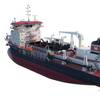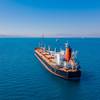Shipping Confidence Dips Again
Overall confidence levels in the shipping industry dropped for the second successive quarter, although they are still up on the corresponding period last year, according to the latest survey by accountant and shipping industry adviser Moore Stephens. Owners in particular appear to be having a rethink about planned new investments and, together with charterers, are anticipating a fall in dry bulk and container ship rates over the next twelve months.
In the November 2010 Moore Stephens Shipping confidence survey, the average confidence level expressed by respondents in the markets in which they operate was 6.0 on a scale of 1 to 10, compared to 6.2 in the previous survey, in August 2010. Confidence over the past three months fell most noticeably on the part of owners and managers (down from 6.1 to 5.8 and from 6.4 to 6.1 respectively), followed by charterers, down from 6.3 to 6.1. Geographically, confidence on the part of respondents in Europe was down from 6.1 to 5.7, while in Asia it remained unchanged at 6.2.
Concerns about overtonnaging and the effect of a glut of newbuildings soon to come onto the market once again dominated the thinking of responses to the survey. “The over-supply of tonnage will outweigh any increase in demand even when that is bolstered by the continuing growth of the Asian economy,” said one respondent, while another noted, “The volume of tanker and bulker newbuildings over the next two years is bound to influence the market in a negative way, and it will take more order cancellations, rather than mere delivery delays, to redress the balance”. Responses to the survey also reflected ongoing concern about continuing economic uncertainty, and doubts about the availability of finance. “The banks are to some extent driving shipowners’ asset play," said one respondent, “which may not be the right thing for owners. Banks are, after all, only banks, and not shipowners.”
Demand trends, competition and finance costs (24 per cent, 18 per cent and 14 per cent respectively) remained the three factors which respondents expected to influence performance most significantly over the next twelve months, as indeed they have throughout the life of the survey to date. But it was significant that tonnage supply on this occasion was also cited by 14 per cent of respondents as a major factor, the highest figure yet recorded in this category. Indeed, for both owners and charterers, tonnage supply featured in the top three factors, to the exclusion of finance costs. Geographically, this was true also of Asia, where tonnage supply was cited as a significant factor by 15 per cent of respondents.
Demand trends were the most significant factor for both owners and brokers, while for charterers and managers it was competition which headed the list. Operating costs, at 11 per cent, continued to feature significantly just outside the main performance-influencing factors, while crew supply, at 8 per cent, reached its highest figure since the 9 per cent recorded two years ago. One respondent emphasized, “Lower quality crews add to increased operating costs and poorer ship performance. In an attempt to attract better quality crews, we are into higher wage costs. But in fact we are still having to fish in the same pond of generally lower quality crews so we actually end up with the same personnel but paying more for them”.
Having risen last time to their highest level since the survey was launched in May 2008, expectations of making a major investment or significant development over the next twelve months were down overall, on a scale of 1 to 10, from 6.0 to 5.6. The biggest changes in this respect were recorded by brokers and owners (down from 5.2 to 4.7 and from 6.0 to 5.6 respectively). Charterers’ expectations remained unchanged at 6.1, while managers (up from 5.7 to 5.9) were actually more optimistic this time around. Geographically, expectations were up in Asia, from 5.7 to 5.9, but down in Europe (5.6 to 5.3).
Overall, 44 per cent of respondents expected finance costs to rise over the next twelve months. This is up on the record low of 42 per cent who thought likewise in August 2010, but still the second lowest figure recorded during the life of the survey, and 22 percentage points down on the figure for May 2008. More managers (up from 45 per cent to 51 per cent) and owners (37 per cent to 41 per cent) expected finance costs to rise, but the number of charterers of like mind fell by two percentage points (50 per cent to 48 per cent).
So far as the markets are concerned, the numbers of respondents expecting rates to increase over the next twelve months was down in all three main tonnage categories covered by the survey. In the tanker sector, there was a dip in the number of respondents anticipating higher rates overall from 48 per cent to 47 per cent. Expectations on the part of owners was down from 50 per cent to 46 per cent, although more managers and charterers were confident this time that rates would increase, up from 51 to 52 per cent, and from 45 to 47 per cent respectively. In Asia, 45 per cent of respondents anticipated higher rates as opposed to 39 per cent last time, while in Europe the figure dropped to 49 per cent from the 52 per cent recorded in August.
In the dry bulk sector, there was a ten percentage-point drop overall – from 42 per cent to 32 per cent – in the numbers of those expecting higher rates, which equals the lowest figure recorded during the life of the survey thus far. This was common to all categories of respondent, and was most marked on the part of managers (down from 46 per cent to 30 per cent) and charterers (down from 46 per cent to 33 per cent). The number of owners expecting higher rates, meanwhile, was down five percentage points on last time to 33 per cent. It was also worthy of note that the number of respondents overall who expected rates to be lower in twelve months’ time was up eight percentage points from 21 per cent in August to 29 per cent this time. Geographically, there was a significant shift in opinion on the part of Europe, where 27 per cent of respondents were expecting higher rates, as opposed to 44 per cent in August. By contrast, 42 per cent of respondents in Asia were anticipating higher rates, up one per cent on the previous survey.
With the exception of managers (up by one percentage point to 49 per cent), no category of respondent was more confident of an increase in container ship rates this time. Overall, 43 per cent anticipated higher rates over the next twelve months, as opposed to 50 per cent last time. Just 25 per cent of charterers thought that rates would increase, down 17 percentage points from last time, while in the case of owners the numbers dropped from 52 per cent in August to 45 per cent this time.
Moore Stephens shipping partner, Richard Greiner, said, “The slight drop in shipping confidence levels over the last three months still finds the industry in a more optimistic mood than it was twelve months ago. Shipping is arguably the most international industry in the world, and that means it is open to a diverse range of influencing factors, which can be both its strength and its weakness. What is very evident from this latest survey is the continuing level of concern about over-tonnaging, and the prospect of this becoming worse as more and more newbuildings are delivered over the next two-to-three years. Like most things in shipping, this is not new, but it will require careful management, by everybody from the shipowners to the banks, until the supply-demand ratio achieves a healthier balance. History tells us that this will happen eventually, and that it is only the identity of the winners and losers which changes over time.
“One reason for optimism to emerge from the survey is an apparent narrowing of the gap between owners and charterers in terms of their expectations. In two of the three main trades covered by the survey - tankers and dry bulk – owners and charterers seem to pretty much agree, in a manner they haven’t before, which way rates are going to move over the coming year. This suggests a high degree of pragmatism, which is always a good thing when trying to ride out a difficult market.
“It was interesting to note this time, also, the concern expressed by respondents over increasing crew costs. Operating costs generally are likely to increase over the next twelve months, and crew costs are going to be the biggest factor in that. But prudent owners and operators will look elsewhere in search of achievable economies, since cutting back on crew costs has been shown to be a false – and very often costly - economy. One respondent evidently saw an opportunity where others could see only problems when pointing out that seafarer training is an area which shows promising growth potential given the severe dearth of competently trained seafarers. Even the darkest cloud has a silver lining.”










